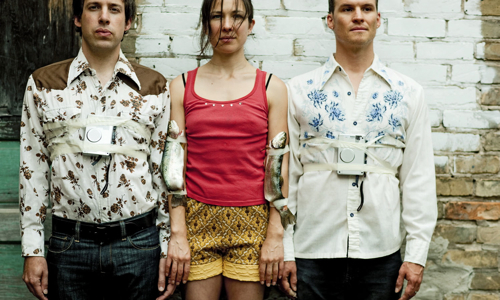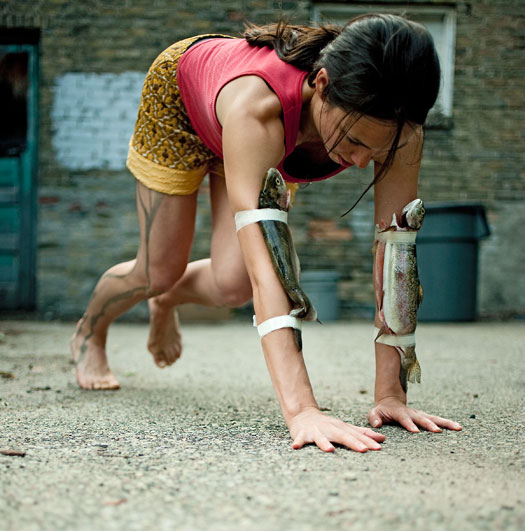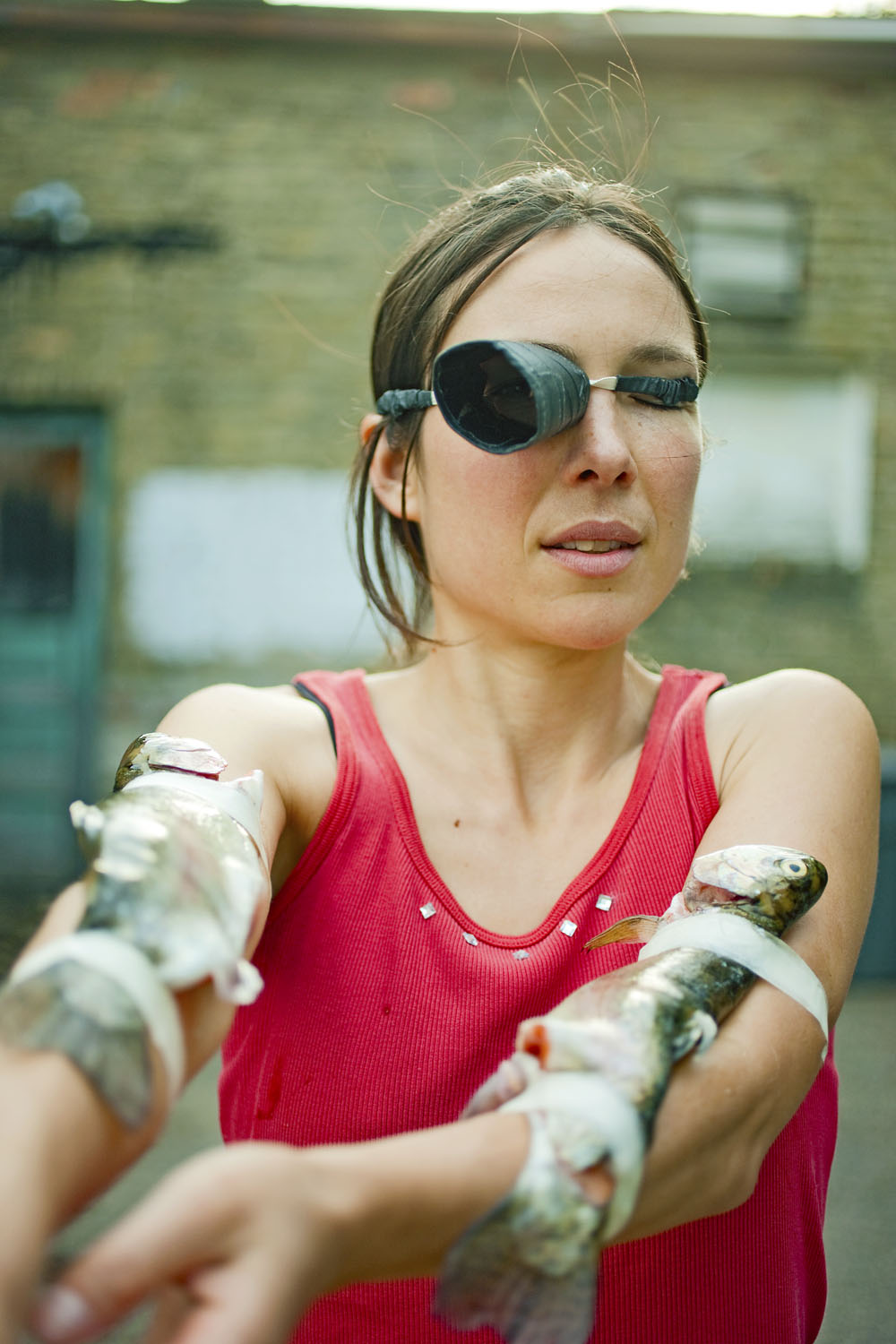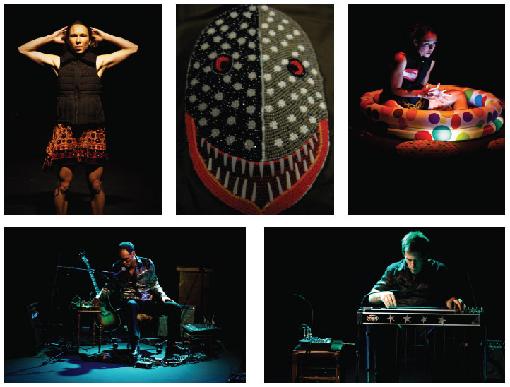A Story to Tell – Emily Johnson/Catalyst + BLACKFISH
Camille LeFevre reflects on the unusually collaborative, evocative performance by Catalyst Dance and the musical duo James Everest and Joel Pickard (BLACKFISH) - "The Thank-You Bar" - on stage at Northrop recently.




ONE OF OUR FIRST GLIMPSES OF EMILY JOHNSON, choreographer and co-creator of the luminous new performance piece, The Thank-You Bar, is on video. She’s lovely and engaging, even if the words of the story she’s telling come not out of her mouth, but from the remove of pre-recorded narration (emanating from a tape recorder tucked in her shirt), and through her facial expressions. Johnson light-heartedly recounts the long and winding tale of a tree, a house, Northrop, and a door in the hallway leading to the Northrop stage that was posted with a handmade sign that reads: “This is a very heavy tree.”
Her beguiling story, about an object historically and culturally displaced in time and space — told by a disembodied storyteller — is captivating. It also sets the stage (so to speak) for a collaborative journey. A charming shaman with an unusual and alluring collection of aesthetic strategies both high-tech and DIY, Johnson graciously invites each individual in the audience to join her, and each other, in exploring a state of mind best called gratitude, or Que-Ana (the Yup’ik word for “thank you”).
The place is the Northrop stage, literally; the 40 or so audience members for this night’s show sit (initially, anyway) to one side of the vast proscenium space, in a semi-circle on stage, facing James Everest and Joel Pickard’s instruments. As The Thank-You Bar unfolds, the boundaries between audience and performers shift and blur. Individual audience members become a community of participant observers, engaged in metaphysical musings on the kinetic and aural imprints we leave behind, the loss of and yearning for place, and a life composed of rich, if sometimes contradictory, impulses.
The piece, actually, begins with a journey. We gather in the Gold Room at Northrop for the pre-performance art exhibition — This is Displacement: Native Artists Consider the Relationship Between Land and Identity, curated by Johnson (who is from Alaska, and one-eighth Yup’ik) and Carolyn Lee Anderson (Dine). A quilt, videos, photos, songs, poetry, and paintings all reveal stories about native peoples’ historical, spiritual and physical displacement. The work is by turns illuminating and haunting, didactic and confrontational. Johnson’s own installation, CIB, 2009, is no exception.
Inside the wood-framed shadow boxes of CIB, 2009 are pieces of freezer paper (the kind in which you wrap and store the deer you shot and butchered, or the fish you caught), smeared with Johnson’s blood. At the bottom of each box are mounds of sand from Mini sota (Dakota) and Alaxsaxaq (Aleut). None of this visceral rawness exists in The Thank-You Bar, however. Rather, Johnson gently lures us with her compelling attentiveness, sweetly hooking our imaginations before subtly reeling us into her world of memory, story, and movement.
She accomplishes this, in part, by deploying a variety of strategies used by site-specific choreographers, including: decentralized points of attention, moving audience members through the building, and engaging their participation. After leaving the Gold Room, walking down stairs and past dressing rooms, while noting handmade signs above a water fountain (“This is delicious”) or a water pipe (“This is a river”), the audience sits in darkness as Everest and Pickard quietly turn on an electronic instrument, create a sound, then leave — only to, by turns, repeat the process. Gradually, sonic layers of sound and text gather force. Then Johnson appears.
She’s on video. She’s on stilts, loudly cracking open one of the auditorium doors and tumbling back and forth down the aisle. She’s on stage, in front of us, describing all of her names, which, it turns out, are our names. Dressed in a tiny sparkly dress, with blue rivulets painted down her legs, she dances and gestures with a grace underpinned by ferocity — one of her choreographic trademarks. She turns lights on and off; she holds lights in her hands and tells stories.
______________________________________________________
Johnson gently lures us with her compelling attentiveness, sweetly hooking our imaginations before subtly reeling us into her world of memory, story, and movement.
______________________________________________________
One of those tales is about seals diving, then resurfacing, in the sea near the beach; after her narration, Johnson, Pickard, and Everest sing softly, ever so softly, Patsy Cline’s classic, “I Fall to Pieces.” The beauty and simplicity of the song and story together are transportive. We listeners are alternately cast inside a memory of unbearable heartbreak and the sublime. Another story recounts her outing as an Indian in elementary school. For just a moment, her disappointment in herself, her disbelief at her classmate, her realization of difference — all coalesces in a moment of silent, anguished tremors.
Then Johnson wheels out an igloo made of paper light boxes. She gives each of us in the audience a light box to hold, then asks us to look up at the ceiling; there’s another sign: “Bats hang on this.” She directs us to turn our chairs in the opposite direction. She walks around with heavy, rhythmic steps. Pickard and Everest perform a series of pedestrian movements accompanied by sounds emanating from devices strapped to their chests.
From there, Johnson dives into strong, lean choreography with a restless flow. She appears to be fighting her way through this mash-up of wonky ballet positions, Native dance movements, and everyday gestures, smiling then grimacing, as a drum beats behind the curtains. She stands on top of a pedestal, joyfully slapping nametags (our names) onto her chest. “Sally,” reads one of those tags, and Sally Rousse (dancer and cofounder of James Sewell Ballet) emerges from the audience to join Johnson in the nametag game, both of them smiling with enthusiasm. Their ensuing dance duet is a study in contrasting styles: Johnson fluid and fierce, Rousse jagged and taut.
Afterward, Johnson has one more story to tell, about the blackfish. Sitting in a kiddie pool filled with leaves, she asks us to gather closely ’round. In this story, the blackfish is a mystery, a slippery trickster that bides its time silently, on its belly, on the river bottoms, or in a fisherman’s bucket before being eaten head first. As the tale progresses, there are too many blackfish, a disassembling goo, a merging of human and fish flesh — it’s her most visceral story, and her most captivating.
And then it’s over; the journey has taken us across the Northrop stage, to Alaska and back to Minneapolis, into cold river water until — like the blackfish — we’ve reached a state of grateful quietude. Through our own movement about the stage, we in the audience have embodied the relentless tug and sense of dislocation Johnson describes feeling, as she shuttles between homes in Minnesota and Alaska, between her Eskimo and European heritage, between the artistic disciplines she appears to navigate so easily. There is blackfish in all of us, Johnson might be saying, and darkness through we can find grace and sustenance.
“Que-Ana,” Emily.
______________________________________________________
Noted performance details:
The Thank-You Bar, by Emily Johnson/Catalyst + BLACKFISH, and its accompanying exhibition were at Northrop Auditorium in Minneapolis on November 19.
______________________________________________________
About the author: Camille LeFevre is a Twin Cities’ arts journalist, and teaching arts journalism at the University of Minnesota.